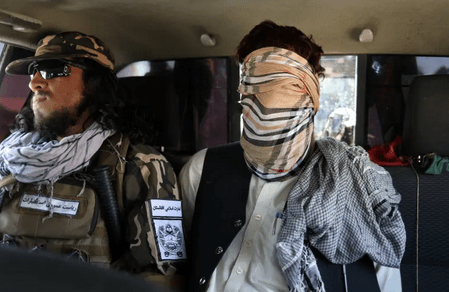
Islamic State terror attacks jump after US Afghanistan pullout
Terror attacks by ISIS spiked following the US pull-out from Afghanistan despite for most of 2021 remaining similar to the levels of violence the group generated in 2020, a Meir Amit Intelligence and Terrorism Information Center report said.
Based on ISIS’s own claims of responsibility, the Center said that ISIS operatives carried out 2,705 terrorist acts around the globe in 2021, compared to 2,718 in 2020.
The height of the attacks was in April-May 2021, during the month of Ramadan, but there was also a particular spike of suicide bombing attacks in Afghanistan in August and October 2021 which “significantly increased the number of casualties” for the year as a whole, said the report.
This corresponded to Washington’s withdrawal.
Over the course of the full year, ISIS’s Iraq Province was the leader in terms of the number of terrorist acts that it carried out – similarly to in 2020.
According to the report, there were no significant ISIS-inspired attacks in the West in 2021, a phenomenon that has continued for several years, “and the counterterrorism activity has taken a toll on ISIS in virtually every arena, and in the Sinai Peninsula in particular.”
“Concurrently with a slight decrease in the number of attacks, in 2021 there was a decrease in the number of casualties, which continues to be high,” noted the report.
In 2021, a total of 8,147 people were killed or wounded in ISIS attacks, compared to 9,068 people in 2020.
The greatest number of casualties were in the provinces of Afghanistan (Khorasan, according to ISIS), Iraq and West Africa.
According to the report, “In Syria, Iraq and Afghanistan, most of ISIS’s terrorist activity took the form of targeted killings and the activation of IEDs by small squads equipped with small and medium-sized weapons.”
Further, “in a significant number of terrorist attacks, ISIS operatives demonstrated relatively high operational capability, carrying out more complex operations, which also included attacking aid forces that arrived at the scenes of the attack, by firing at them or by planting IEDs ahead of time.”
The Meir Amit Center gathered information about ISIS activity around the globe over the past year, based on its claims of responsibility published in its media, and in the Al-Naba’ weekly in particular.
It said that some of the incidents have been verified with reports from local sources.
Further, the report said that the actual number of terrorist acts carried out by ISIS might be higher if in some cases the group “did not issue a claim of responsibility for some of the attacks or because communication problems prevented the information about them from reaching its main media center.”
The figures for 2020 were compiled by Tore Hamming (a social and political researcher at the European University Institute in Venice).
A separate report by the intelligence center said that while security incidents since late May from Gaza had been heavily reduced, stabbing incidents in the West Bank and east Jerusalem had gone up.
The report did flag 3,631 rockets and mortars fired from Gaza at Israel, mostly during the May 2021 war with Hamas and Islamic Jihad.
During that period 14 Israelis were killed.
However, besides that period only one IDF soldier was killed by sniper fire in a separate incident and since May, only four rockets have been fired on Israel.
“This means that with the exception of May, there continues to be a downward trend of rocket fire from Gaza and of security events near the border fence,” said the report.
The Center assesses that Hamas and Islamic Jihad are temporarily deterred from a new conflict by their losses during the May war, but that this deterrence may prove thin and short-term.
One area where Palestinian terrorism got worse was in the area of stabbing attacks where the increase reached 30 attacks for 2021, which made up 56% of the attacks, as opposed to 19 attacks in 2020, which made up 48% of attacks that year.
Still, despite that increase and “despite the May 2021 Gaza war, the level of Palestinian terror in the West Bank and east Jerusalem remained at a similar level to what has characterized it in recent years since 2017.”
In 2021, the Meir Amit Center said there were 54 substantial terror attacks as opposed to 40 in 2020, 34 in 2019 and 55 in 2018.
Substantial terror attacks are defined as those in which potentially deadly violence is used.
For comparison farther back, during the Knife Intifada of 2015-2016, the number of substantial attacks reached 171 and 142 respectively.
However, only three Israelis were killed during these attacks (which was identical to the two prior years) possibly due to many of them involving stabbings, rammings and other attacks without guns.
Regarding breaking down the attack, there were still 12 shooting attacks (which made up 22% of attacks) , eight ramming attacks (which made up 15% of attacks) and some miscellaneous other attacks.
34 Israelis were injured in 2021 as opposed to 46 in 2020.
There were 20 attacks in east Jerusalem and there was one attack within the Green Line in Yafo.
In addition, there were around 1,700 rock throwing incidents and around 350 incidents of Molotov cocktail attacks.
The report also noted an increase in 2021 in ideological Jewish violence against Arabs and Palestinians.
Source: JP





